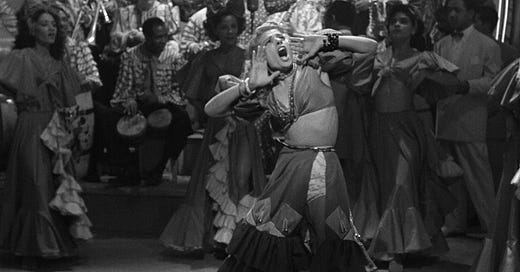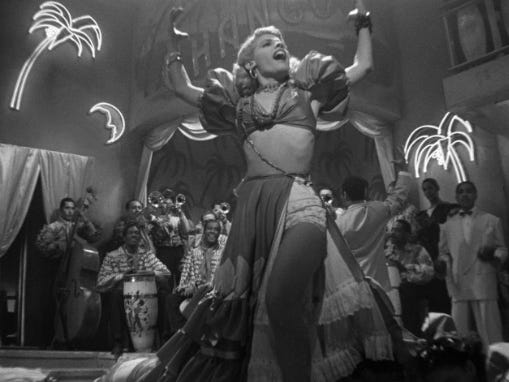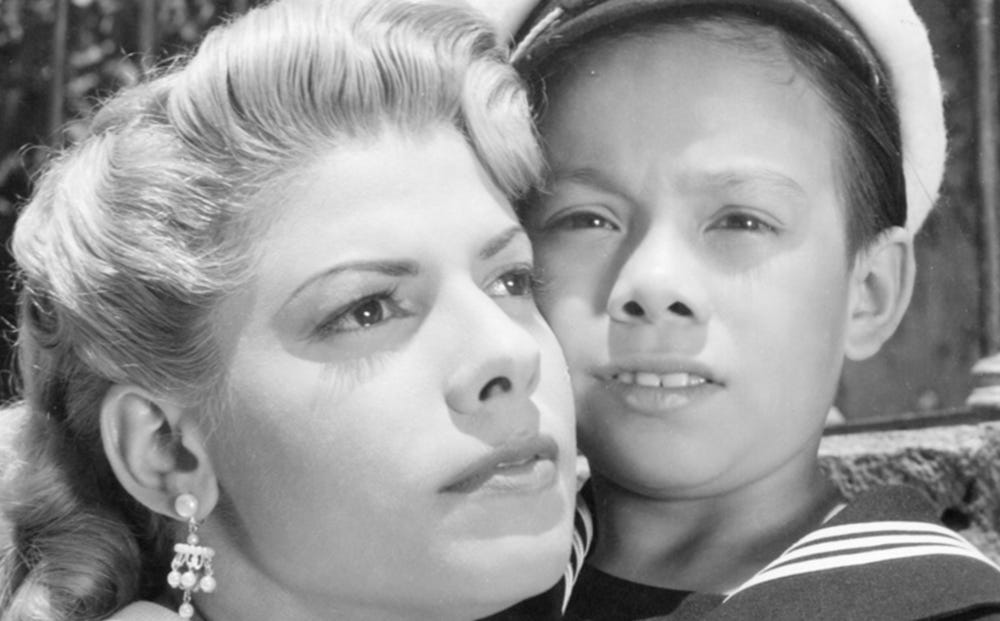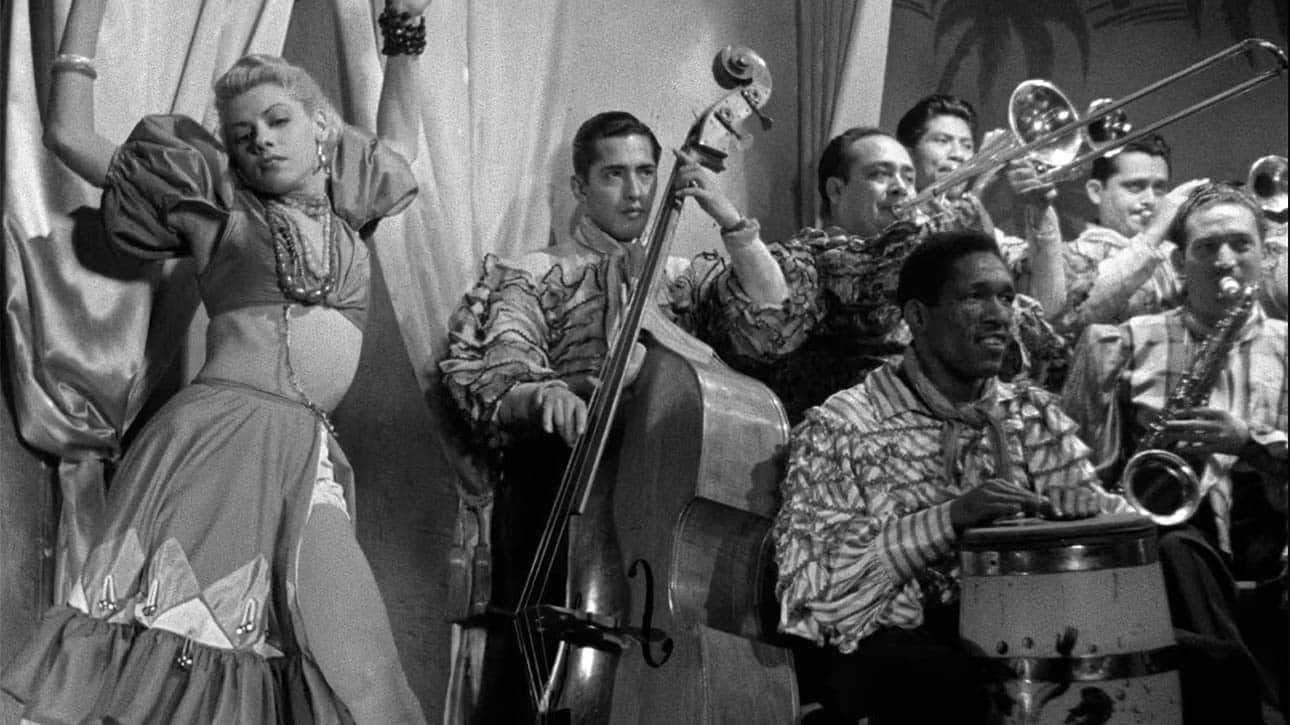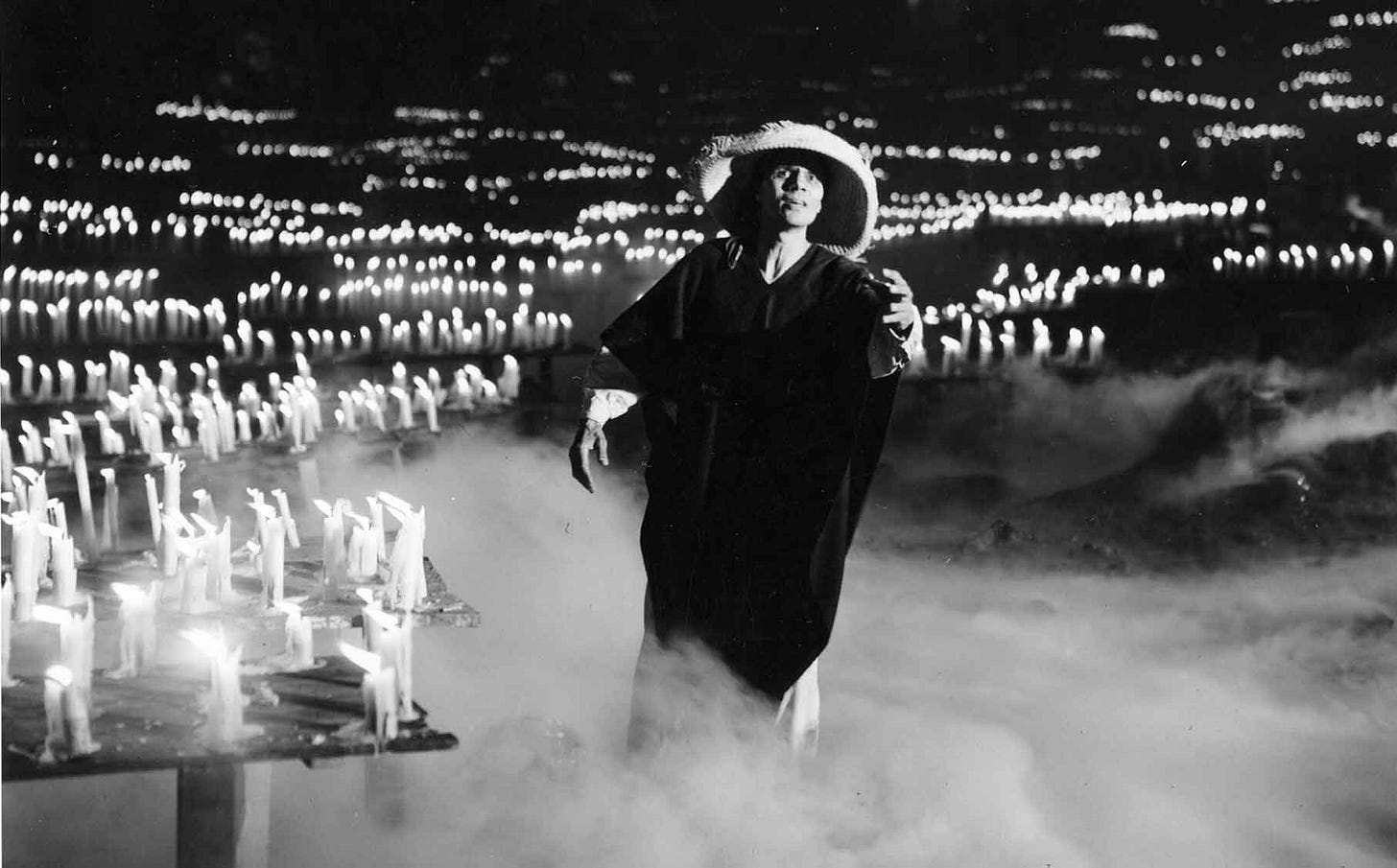Today, September 15, marks the first day of Hispanic Heritage Month in the United States! I’ll have a full 10 film list of recommendations from various Spanish-speaking countries later in the month, but I wanted to focus on one in particular for this subscriber special. That title is Emilio Fernández’s Victims of Sin, a genre-defying 1951 film from Mexico’s Golden Era. A recent 4K restoration just received a Criterion Collection release and is now available to stream on the Criterion Channel.
It’s probably easiest to qualify Victims of Sin as a classic film noir given its dive into the seedy, sordid underbelly of a newly booming Mexico City. The protagonist, Ninón Sevilla’s Cuban dancer Violeta, strives for excellence across multiple fronts working at a cabaret in the red light district. She’s got a personality as big as her performances, though she’s grounded with a salt-of-the-earth spirit as shown by her decision to adopt the abandoned child of a colleague. The film always threatens to teeter over into florid melodrama or miserabilist neorealism, but Fernández walks an impressive tightrope keeping everything in order as the baby’s father makes his dramatic re-emergence.
This is a movie that largely came to my attention thanks to the praise and curation of my friend Monica Castillo, a critic and senior film programmer at the Jacob Burns Film Center. (She also tolerated me as a roommate in Sundance this year.) I wanted to get her perspective on Victims of Sin from a wider lens of Mexican and Hispanic cinema, and below you’ll find excerpts of our conversation.
I want to make it clear that I did specify you did not have to do homework for this, but I did see you watched Victims of Sin again last night. What stood out to you on the rewatch?
I was really taken with the film's editing and the way that it shoots musical sequences. I have a big music or dance background, I should say, so I do pay attention to those spotlight moments in a little different way. I'm watching the choreography of Ninón Sevilla, the dancer, and I believe she's Cuban as well. She has a really fascinating story because there wasn't a Cuban film industry at that time. She came over just at the right moment in Época de Oro (the Golden Era) of Mexican cinema. And she worked with Emilio Fernández, one of the best directors of his generation, and Gabriel Figueroa, one of the best cinematographers of that era. She creates this beautiful performance that's intense, a bit melodramatic, and quite a bit over the top as a lot of Mexican cinema was at that time. It's really moving to see how she advocates for herself and the child that she takes under her wing.
Of course, her dance performances are really impressive. She does a number of different forms of dance between Afro-Cuban Rumba to a little bit of Mambo, and she uses that talent to get her through some of the tougher points in the story. The camera itself does close in on her. You see the intensity of her movement from her shoulders up. You see her whole body in long shot. It's a lot of quick cuts, which you don't usually see that in film of that time, that adds to the intensity and the vibrancy of the rhythm of these dances. So I was really smitten with those moments.
You don't see editing of that style around the musical performances until the MTV era for the most part. At the time, it was almost like filmed theater for musical performances at the time with one long shot almost like you're watching them as spectators of a stage.
Fred Astaire was a very big proponent of that. He wanted to see the whole dancer because you communicate everything through all of that. But to take it piecemeal, some dancers are for it and some opposed it. In this case, I think it really works to add to that frenetic energy of what's going on.
Let's talk a little more about the actress Ninón Sevilla, who is Cuban like your family but is the star of this Mexican film. What does her casting tell you about the concept of Latinidad?
That's a very big question. There is a moment in the film with one of the other dancers not at Changó ... which, by the way, has its own history. El Changó is a significant god in the Santeria religion. The beginning song is a tribute to Changó, the figure. That's all rolled into the entertainment, and that's one of many things happening in the background. It plays a little differently for me than it might for some other folks who may not be as familiar with the name. But in terms of the cultural exchange, you see these different highs and lows of different industries when their respective governments come in and help support them or when capital comes in and is able to help their respective national cinemas blossom. Sometimes, you have to go where the work is.
Ninón Sevilla was one of the many performers who went abroad. There is also Pérez Prado, one of THE mambo kings. He came to Mexico to work because there weren't as many opportunities in Cuba at that time. There was also a lot of segregation in Cuba, so he and other band leaders [left]. Some went to New York City where they helped establish Mambo here, and it became a groundswell that Tito Puente was a part of as well. It's a very fluid exchange.
Her accent, to me, sounded Cuban. We are different. We do speak differently. We do have different accents. We do maybe use words a little differently. That still shows up here and there. Sometimes, it works better than others. It's not immediately apparent that Ninón is playing a character who is Mexican if you're not trying to listen for that. In other cases, it could not fit, and that could be the tell. This came up in conversation with me recently when we were reminiscing about Wasp Network, where Olivier Assayas hired mostly non-Cuban actors to play Cubans. Those accents are all over the place. There are background actors and extras who have a line here or there that remind you it sounds very different.
I feel like this film is far ahead of its time in its depiction of sex work — and honestly, maybe still even better than modern movies. Does the depiction of rumberas strike you as something more than the Hollywood archetype of the “stripper with a heart of gold” à la Marisa Tomei in The Wrestler?
It does seem a lot deeper, especially thinking about this film in the context of noir. I saw these women as inherently in that underdog position. They are the ones being oppressed by the world, having doors thrown at them, and being mistreated by men who feel entitled to do so just because of how they are trying to survive. It feels very sympathetic. It's trying to understand why women would put themselves in this position and explain to the audience this is nobody's first choice, but this is what's being done. Our hero is making those decisions firsthand, and we're following her through that journey. There's a moment in the film where the man who she defied early on in Act One finally gets out of jail and returns to try and exact as revenge. He begins to beat her, and a swarm of women come in to defend her. There's a little bit of sisterly solidarity in fighting back against violence that I thought was really striking for that time and moment.
That reminded me a lot of the women in Pedro Almodóvar’s films, who oftentimes band together and sustain their communities when men cannot. An instant difference I saw between Victims of Sin and how an American film would probably tackle the same subject matter is that all the women of Cabaret Changó cooperate rather than compete with each other.
I don't know, because I can see something like Sweet Charity where there is a sense of solidarity among the dancers there. They support each other in their hopes and dreams and want [each other] to succeed.
You brought up noir, and I struggle somewhat putting it in that genre. I think I struggle putting this movie in any kind of genre because it's so eclectic. Victims of Sin has a lot of the visual and thematic hallmarks of film noir, but it feels a bit too optimistic for the devastation of the post-war grimness that birthed the genre.
I am inclined to agree. I don't think every noir has to end tragically, at least not on my end. This does feel like a feminist-ish pushback against male violence and domination. The fact that she's able to accomplish everything that she does is a testament to survival at any cost, and her determination to protect the child she adopts a child from a coworker who has abandoned him because a man told her to. She's not going to accept that anymore. She's not going to turn the other cheek. She's not going to look the other way. She's going to fight for herself and this baby.
I don't want to do the "this movie from 1951 doesn't comport with how we view women today, thus it's bad and problematic" thing, but it does flirt a little with the slightly regressive trope of a woman becoming a mother and is instantly changed. Ninón Sevilla's performance is so great that I didn't mind it too much, and she somewhat balances it because this isn't her biological child and becoming a mother does not supersede all other identities.
It's definitely not her sole identity. And I would say that change started before the arrival of the baby. It is hinted that she's taken it upon herself to study dancing and to be mentored by another performer. She's already bootstrapping her way up in the club ranks, if you will. She's not settling for just being arm candy. This is a part of that journey to self empowerment.
Some of the melodrama in the film does make it feel a little bit like an early forerunner to the telenovela. I know “soapy” often feels like a pejorative when wielded by critics, but I do think those programs are such vital cultural objects and exports from the Spanish-speaking world. How do you feel about them and the way Victims of Sin might be working in the same register?
Having watched like a fair amount of Latin American cinema, I think the performing style is just a little bit more exaggerated than what we're used to here in the States. That well predates the telenovela. If you even watch like Argentine cinema from this decade and earlier, they're a little bit more on the dramatic flair. They are not so understated as their American counterparts, and I think you see this here as well. It also allows for the actors to have fun! I'm not going to say it's camp, because it's not, but it's a little more overstated. They're having fun with it, and it is sometimes more fun to watch. It is sometimes more fun to cheer on because it is so over the top. This one doesn't go as heavily as some of the other ones I've seen. There is a balance, but there is a fondness for the dramatics that is all part of that tradition.
Victims of Sin feels remarkably free of cheap moralizing, even though the mariachi musicians do function like something of a Greek chorus. Is that at all an outgrowth of the conditions within Mexico, which was rapidly urbanizing at the time in ways that felt like the country was making real forward progress?
Considering that this is just a few years after WWII, I think people were holding on to the idea that it could only go up from here. They still might have to fight for it, which is what I think this film is tapping into. But there is that hope. The mariachi is definitely a Greek chorus, and they are singing to things that are going on in the film — which is not uncommon. Some mariachi songs do tell stories, legends, or folktales of people's experiences. I think it accentuates the story quite nicely, and it's also very dramatic especially as the use of music goes on. There's that beautiful start and stop at the beginning before they launch into the song that almost feels modern. It doesn't feel as classical as a traditional mariachi song might might sound. It's almost like a different riff before starting into their song. I love that they follow the character that they're singing about along!
The great Criterion supplemental material with cinematographer Rodrigo Prieto (of Barbie AND Killers of the Flower Moon) pointed out how the visuals of Victims of Sin offer a cinematic equivalent of the great Mexican artist Diego Rivera’s murals in their horizontal compositions and pans. Is there anything else you think deserves elevation as being a reflection of Mexico or the Spanish-speaking world that might not be as evident to those less familiar?
If people are interested in the different types of dancing, I would recommend people look into the differences between them. Afro-Cuban Rumba, the first number that Sevilla performs, is a traditional ballroom-esque rumba that people will dance together in a closed social dance. Then mambo, which was just starting to really hit its stride at that time, is what she dances towards the end. It's a little bit faster paced and has a lot of different instruments. (Pérez Prado is a really interesting figure for people to check out as well.) I love the musical aspect of this. Until the restoration, it wasn't on my radar, so it was a rediscovery of this beautiful film, these talented performers, and works by incredible filmmakers.
Mexican, and to an extent Cuban, industries were decently developed at mid-20th century despite that the “global community” had eyes for little else besides the United States, Europe, and Japan. What are we missing by having ignored films like Victims of Sin from this culture for so long? What work remains to be done to elevate its presence?
I think the restorations go a long way in helping people know that these are available and exist. Part of the reason why I hadn't seen these films was because they weren't as widely available. Unless you knew to seek this out, where would you find this if it didn't have U.S. distribution? Where would you find this if the best copy at that time might have been an old bootleg VHS? Now is a wonderful time for rediscovery because we are finding films like Victims of Sin and others through international restorations through The Film Foundation's World Cinema Project, which is elevating these titles from around the world in various countries that may still have a problem getting international recognition. It goes a long way into teaching people about each other, but also themselves,by seeing these different experiences reflected through the ages.
It does not escape me how infrequently the major festivals program films from Latin America or Spanish-language cinema, with the exception perhaps of Spain.
Yeah, it's fairly rare, and the odds are many of those great titles that you do see at a festival will not get U.S. distribution. They're tougher to to seek out. Some things have gotten better; obviously, the internet has helped in a big way. But in terms of actually getting theatrical and physical media release, or even just letting people know that these films exist, it's still an uphill battle. People are still fighting that fight.
If someone liked Victims of Sin, where would you point them next in Spanish language cinema?
Personally, I want to go back and see more of Ninón Sevilla's work. I wasn't familiar with her beforehand in the same way that I was with Emilio Fernández and Gabriel Figueroa. This was a really great first introduction, and now I just want to see more. Exploring the works of the other two figures that I just mentioned is a really great starting point. María Candelaria is one of the big classics of Mexican cinema that Emilio Fernández made. That stars Dolores del Rio, who had a stateside career until that fell out of favor. Then, she found a whole new resurgence when the Golden Age of Mexican cinema was in full swing. You'll see a lot more of her works from down there than you would from the opportunities that she was afforded in Hollywood.
And then Gabriel Figueroa was one of the main collaborators with Emilio Fernández, but he lensed so many beautiful films. I have Macario, which is a horror movie, on my watchlist. It was one of the earlier Mexican horror movies from 1960 that Guillermo del Toro has also championed. That also just has a new restoration out, and I'm excited to see that on the big screen. I've heard wonderful things about it, but he's known as Mexico's master cinematographer. His work is just rich with hit after hit after hit after hit.
If you want to read more of Monica’s work, her bylines have appeared in NPR, the New York Times, Los Angeles Times, Washington Post, Colorado Public Radio, KCRW, RogerEbert.com, The Wrap, Remezcla, Elle Magazine, Mashable, and Vulture among others. She is a member of the National Association of Hispanic Journalists, Online News Association, and the Critics Choice Association. She’s also on Twitter at @mcastimovies.
Yours in service and cinema,
Marshall


